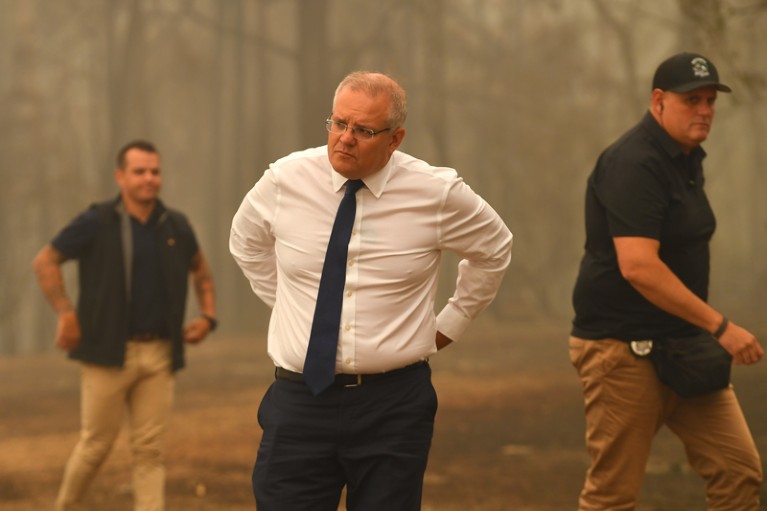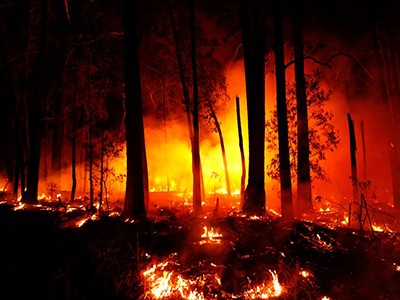
Australian Prime Minister Scott Morrison visiting a fire-hit area in Victoria.Credit: James Ross/Getty
Last November, as bush fires began to roar across large swathes of Australia, people started to ask: could such an extreme event be connected to climate change?
Prime Minister Scott Morrison dodged the question. Gladys Berejiklian, the premier of the state of New South Wales, where the fires have had the biggest impact, said that during the unfolding disaster was not the time to talk about climate change. Two months on, this season’s devastating conflagrations have killed at least 28 people and an estimated one billion native animals; burnt about 10 million hectares of vegetation; and destroyed more than 2,000 homes.
The top priority is to protect lives and ecosystems. But the nation’s leaders must surely realize that they not only need to talk about climate change, but also need to act decisively to reduce the emissions that are driving it.
Australia’s leaders have known for many years that climate change would make bush fires worse. They were warned in an independent report commissioned by the national and state governments in 2008 that from 2020 onwards, fire seasons would start earlier, end later and be more intense.
But as Nature has frequently reported, the country’s politicians delayed meaningful action through a wasted decade of arguments over whether human activities are causing climate change — in the face of overwhelming scientific evidence that they are. Undoubtedly, one reason for this is that Australia — which is the world’s largest coal exporter — has repeatedly prioritized the coal industry’s needs over the planet’s.
Not enough
The government now says it is on track to reduce greenhouse-gas emissions by 26–28% of 2005 levels by 2030, to meet its commitment under the 2015 Paris climate agreement. Its plan includes a policy to pay farmers and businesses to restore or protect native vegetation, and a programme to encourage energy efficiency.
But commitments on such a scale — whether from Australia or other countries — are insufficient to limit warming to below 2 °C above pre-industrial levels, the goal of the agreement. And a significant portion of Australia’s planned cuts is to be achieved through accounting tricks, rather than actual emissions reductions. The government plans for around half — 367 million tonnes of greenhouse gases — to come from ‘credits’ it accumulated by surpassing its targets under the previous climate agreement, the 1997 Kyoto Protocol. That means its actual cuts will be 15% from 2005 levels. No other high-income country that has signed the Paris agreement has said it will transfer its Kyoto credits in this way — and nor should Australia.
Catastrophic Australian bushfires derail research
Last week, after international outrage over his lack of leadership, Morrison switched gears. He started talking about how, as a result of the catastrophic fires, the government would focus on actions that build resilience and adaptation to extreme events, such as bush fires, heatwaves and droughts.
For Australia, that’s a significant move — but it is not enough. The government has to do much more to cut its emissions, too. Just reacting to the impacts of climate change without addressing the cause is like treating people for lung cancer while continuing to let them smoke.
Australia’s tragedy is that more-extreme fires are already forecast. Centuries of greenhouse-gas emissions have locked the world into several decades of warming, even if global emissions were to drop to zero now. If the Morrison government continues its current trajectory, then the country is likely to experience even more severe droughts and fires.
The Morrison government has to make a choice: does it want Australians to live with fires that are becoming worse than those in the past but which can still be managed to some extent? Or does it want to put citizens at risk of future fire conditions that are even more catastrophic than this season’s? There can be only one answer to this question if the government accepts that its first role is always to protect its citizens and its country.
We frequently hear the argument that actions from individual countries such as Australia will, on their own, make little difference to global warming. But that is why we have global agreements. Change will come when everyone acts in concert. Australia, along with the United States, China, the European Union and others all have to play their part, leading the way on decarbonizing energy for households, industry, transport and more.
Instead of arguing with its climate researchers, Australia’s government needs to work with them to accelerate this transition, and to ensure that, as far as possible, lives and livelihoods are protected when change arrives. A country on the front lines of climate change has no other choice.

 Catastrophic Australian bushfires derail research
Catastrophic Australian bushfires derail research
 ‘Deathly silent’: Ecologist describes Australian wildfires’ devastating aftermath
‘Deathly silent’: Ecologist describes Australian wildfires’ devastating aftermath
 Australia’s capital city switches to 100% renewable energy
Australia’s capital city switches to 100% renewable energy
 How Australia’s election will decide its role in climate change
How Australia’s election will decide its role in climate change



